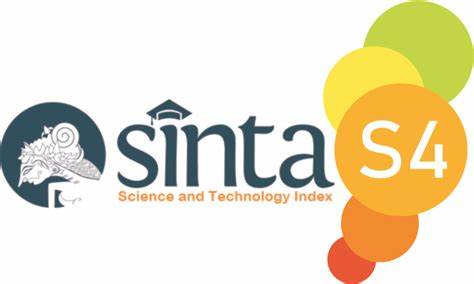PENGEMBANGAN PERANGKAT PEMBELAJARAN BERBASIS MODEL INQUIRY TRAINING TERHADAP PEMAHAMAN KONSEP SISWA PADA MATERI GETARAN HARMONIS
Abstract
This study aims to develop learning tools using the Inquiry Training model on Harmonic Vibration material. The learning tools developed are RPP, LKPD, and Concept Understanding Tests. The research method used is Research and development (R&D) to produce products and test the effectiveness of these products, in this case in the form of learning tools. Research design uses the 4D model, namely Define, Design, Development and Dissemination. The data collection technique was validated by a validator consisting of three people, namely, two supervising lecturers and one discussing lecturer. Based on the results of the study, it was obtained that the average validity-2 Learning Implementation Plans (RPP), Student Worksheets (LKPD), and concept understanding tests were 3.43 very high categories with validity criteria, namely valid. The results of the validity-2 RPP were 3.42 very high categories with validity criteria namely valid, the results of the validity-2 LKPD were 3.52 very high categories with validity criteria namely valid, and the results of the validity-2 concept understanding test were 3.36 very categories high with the criteria of validity that is valid. Based on the results of the data analysis obtained from the research conducted, it can be concluded that the development of learning tools oriented to the Inquiry Training learning model on SMA harmonic vibration material was declared valid by the validator with the results obtained in validation-2 being in the very high category and can be used as material teach in the learning process in schools.
References
Apriani, D., Islami, N., Education, P., & Program, S. (2017). the Cognitive Learning Outcames of Physics Science Through the Implementation of Playing Answer Cooperative Learning Model on the Expantion. 4(1), 1–9.
Azhar. (2013). Pengembangan Instrumen Penilaian Kompetensi Sosial Guru Fisika SMA / MA. Prosiding Semirata FMIPA Universitas Lampung, 4, 293–305.
Brumer. M, A. B. M. R. and V. R. (2004). Dynamic, Open Inquiry in Biology Learning. Science Education.
Douglas.C.Giancoli. (2001). Fisika (ke lima). Erlangga.
Eggen. P dan Kauchak. D. (2012). Strategi dan Model Pembelajaran. (terjemahan) edisi keenam. Penerbit Indeks.
Iif Khoiru Ahmadi. (2011). Strategi Pembelajaran Berorientasi KTSP. PT Prestasi Pustakaraya.
Joyce. B, W. M. dan C. E. (2011). Models of Teaching. Pustaka Pelajar.
Mayub. A. (2005). E-Learning Fisika Berbasis Macromadia Flash MX. Graha Ilmu.
Pusat Kurikulum Depdiknas. (2003). Badan Penelitian dan Pengembangan. 2003. Standar Kompetensi Mata Pelajaran Fisika SMA dan MA.
Reichenbach, A., Bringmann, A., Reader, E. E., Pournaras, C. J., Rungger-Brändle, E., Riva, C. E., Hardarson, S. H., Stefansson, E., Yard, W. N., Newman, E. A., & Holmes, D. (2019). ANALISIS TINGKAT KEMAMPUAN PEMECAHAN MASALAH GETARAN HARMONIS MELALUI MODEL PEMBELAJARAN PERUBAHAN KONSEPTUAL. Progress in Retinal and Eye Research, 561(3), S2–S3.
Siddiqui, & M. H. (2013). Inquiry Training Model of Teaching : A Search of Learning. 2(2), 108.
Sugiyono. (2010). Metedologi Penelitian Pendidikan.
Taluke, D. (2019). ANALISIS PREFERENSI MASYARAKAT DALAM PENGELOLAAN EKOSISTEM MANGROVE DI PESISIR PANTAI KECAMATAN LOLODA KABUPATEN HALMAHERA BARAT. Jurnal Spasial, 6(2).
Taufik, M., Nasir, M., & Syaflita, D. (2022). Application of Learning Media Game an Intel ’ s Science Missions Based on Borland Delpi 7 on Static Electricity Material to Improve Students ’ Cognitive Learning Outcomes. 05(12), 289–292.
Tipler. (1998). Fisika untuk sains dan Teknik Edisi Ketiga Jilid 1. Erlangga.
Trianto. (2012). Model Pembelajaran Terpadu. PT Bumi Aksara.
Trianto. (2013). Model Pembelajaran Terpadu. PT Bumi Aksara.
Ulfah, A., Pasani, C. F., & Kamaliyah, K. (2021). Pengembangan Tes Formatif Matematika Materi Persamaan Garis Lurus Berbasis Higher Order Thinking Skill (Hots) Untuk Siswa Smp. EDU-MAT: Jurnal Pendidikan Matematika, 9(1), 48. https://doi.org/10.20527/edumat.v9i1.10405
Wardhany, R. P. K. (2014). Media Video Kejadian Fisika Dalam Pembelajaran Fisika Di SMA. Jurnal Pembelajaran Fisika, 2301–9794, 1–8.
Wena Made. (2009). Strategi Pembelajaran Inovatif Kontemporer: Suatu Tinjauan Konseptual Operasional. PT Bumi Aksara.






.png)







